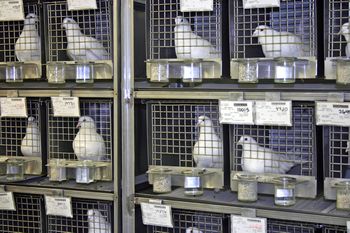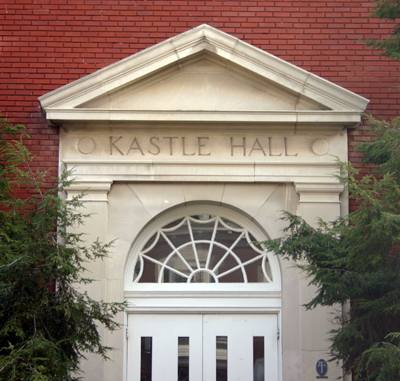Research
Research in the Comparative Cognition Laboratory covers a broad range of topics determined by the interests of the researchers in the lab. We have found that if pigeons have to expend greater effort to obtain a stimulus associated with food, they prefer that stimulus over one for which they do not have to work as hard. As with humans, pigeons value rewards more if they follow greater effort. This result is similar to what has been called justification of effort when it occurs in humans.
We are also interested in the numerical competence of pigeons. We have found that if pigeons are given a sequence of four trials in which they must peck 10 times in order to receive food, (but they only receive food on the first three trials), they take significantly more time to complete the fourth trial.
Another topic of interest at our lab is subjective timing. We want to know if pigeons, like humans, judge the passage of time differently as a result of other events that are taking place. For example, does time fly when pigeons are have a secondary task to perform?
We are also asking pigeons if they can remember a recently experienced event when they are unexpectedly asked. This ability can be thought of as a kind of episodic memory.
Recently, we have embarked on a series of experiments exploring the tendency of pigeons to choose suboptimally. When they are given a choice between a signal for 10 pellets of food 20% of the time and a signal for 0 pellets 80% of the time, over a signal for 3 pellets 100% of the time, they prefer the first alternative even though on average it gets them less food. Much like gamblers who buy lottery tickets or who play slot machines pigeons who would be better off not gambling, pigeons would be better opting for the sure thing (3 pellets, i.e., not gambling).
Work Ethic/Cognitive dissonance is a phenomenon that occurs when a persons beliefs and actions do not match. For example, a smoker who believes that cigarettes are bad for ones health but continues smoking may experience some discomfort because their actions do not coincide with their belief. A special type of cognitive dissonance is called justification of effort. This occurs when humans assign greater value to rewards that are difficult to obtain. For example, an A earned in an Organic Chemistry course is more highly valued than an A earned in a physical education course.
Our lab was interested in studying whether a similar justification of effort effect could be found in animals, such as rats and pigeons. Clement, Feltus, Kaiser, and Zentall (2000) found that pigeons, as humans, prefer rewards that follow greater, rather than lesser, effort. However, the authors proposed a non-cognitive explanation for this behavior known as the contrast effect. The idea behind this model is that there is a greater change in internal state between expending great effort and earning reward than between expending little effort and earning reward. In any situation where there are two kinds of trial, one with an initial event that is preferred over the other, the contrast hypothesis predicts that animals will prefer the reward following the non-preferred event. Several variations of the original experiment have been conducted and the results support the contrast hypothesis.
Episodic memory is the ability to recall from memory details from past, personal experiences. Tulving (1972) proposed that in order to demonstrate episodic memory, one should be able to recall what, when, and where regarding the event in question. However, in our lab we believe that recalling what, when, and where sometimes may not be sufficient or necessary.
In order to observe the presence of episodic-like memory in pigeons, our lab proposed that the question being asked must be unexpected. This would eliminate the possibility of having a prepared answer (factual or semantic memory). The question proposed to the pigeons in our design was: “Where did you last peck?”
In Phase 1, pigeons were required to peck a white key light that would appear either on the left or right key. They were then presented with red and green comparisons, and would have to peck the color associated with the location of the previously presented white light (e.g., red indicates that the left key was pecked).
In Phase 2, the pigeons were given a symbolic matching task in which they were presented with either a vertical or horizontal line sample and blue and yellow comparisons. If the sample was vertical lines, blue would be correct. If the sample was horizontal lines, yellow was correct.
On test trials, after the pigeons had pecked either the blue or yellow comparison following the line sample, they were presented red and green comparisons on the left and right keys (i.e., they were asked which key they had just pecked). We found that the pigeons chose correctly suggesting that they had some episodic-like memory.
Numerical Competence refers to how an organism organizes objects based on number. We have been examining the ability of pigeons to evaluate the number of a particular event that has been experienced. Pigeons that have experienced three trials in a sequence in which food has been provided for pecking learn that they will not be fed on the fourth trial of the sequence. The results suggest that pigeons are able to make numerical judgments independent of other cues such as the passage of time or the amount of food consumed.
Subjective timing refers to the fact that judgments of the passage of time can be affected by what an organism is doing while it is timing. When subjects learn a temporal discrimination in which different responses are required when the stimulus duration presented is short or long, one can assess the nature of the temporal dimension by examining the distribution of responses that result from presenting intermediate durations. Of particular interest is the point at which subjects judge a duration as equally like the short and long training duration (the bisection point or point of subjective equality). We have found that, not unlike a similar phenomenon in humans, if pigeons are required to peck while they are timing, they tend to underestimate the passage of time and when they are required to refrain from pecking they tend to overestimate the passage of time.
By the age of two years children develop the ability to search for objects that have disappeared from view. Piaget (1954) called this ability object permanence and assessed it using both visible and invisible displacement tasks.
In a visible displacement task an experimenter hides a toy inside one of several identical containers and the child is allowed to search for the hidden toy. One version of the invisible displacement task that has been used with children involves a rotation apparatus on which three identical containers are evenly spaced (left, center, and right). The experimenter hides a toy inside one these containers and then rotates the platform 180°. At 30-mo-old, children do not search accurately when the toy was hidden in the left or right container (Barth & Call, 2006). Fiset (2007) found that under similar conditions, dogs do not search accurately.
However, it may be that the 180° rotation task is exceptionally difficult for children and dogs because the contextual or environmental cues present before and after the rotation remain the same. We eliminated the ambiguity by rotating the apparatus 90° instead of 180° and found that dogs did indeed search accurately when the beam was rotated 90° and the contextual ambiguity was eliminated.
Imitation — The ability to imitate is of special interest to comparative cognition researchers. Humans and especially children are fantastic imitators. A child can observe someone perform an improbable behavior and then can perform that behavior him or herself. It has been proposed that the child is capable of engaging in this new behavior because it understands the relationship between its own behavior and the behavior being modeled by another (Piaget, 1962). Thus, the ability to imitate may require the ability to take the perspective of another. Perspective taking is often deemed a trait that is unique to humans. Yet, under some conditions, animals demonstrate behaviors that appear to be imitative. If their behavior is truly imitative then at some level animals may be able to take perspective as well. To determine whether animals can imitate, we have developed procedures that control for alternative explanations.
In the bi-directional control procedure, first described by Heyes and Dawson (1990), there is one object (like a rod or a screen) that can be pushed in one of two directions. A demonstrating animal pushes the object in one direction while another animal (the observer) is watching. After the demonstration, the observer is tested for how it interacts with the object. Heyes and Dawson found that observer rats pushed a rod in the direction that the demonstrator rat had pushed.
Klein and Zentall (2003) in our lab used the bi-directional control procedure with pigeons but in their design, observer pigeons viewed a demonstrator push a feeder-blocking screen to the left or right of a feeder opening. They found that following the demonstration, the observer pigeons pushed the screen in the same direction as they had observed it being pushed. They also found that control pigeons that saw the screen move to the left or the right (but not pushed by another bird) did not learn which way to push the screen. They also found similar results when they tested Japanese quail with the bi-directional control procedure (Akins, Klein, & Zentall, 2002). In 2008 Miller, Rayburn-Reeves and Zentall found that dogs can also learn how to push a screen to the left or right after they watched another dog demonstrate. Thus, it appears that under the right conditions imitative learning can be found in several species.

